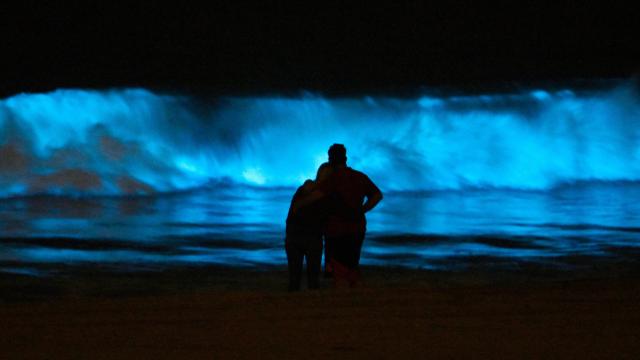Stunning bioluminescent waves are crashing onto southern California shores. It’s quite the spectacle, but the light show is drawing crowds amid social distancing concerns.
Shores between Baja California and Los Angeles are experiencing a significant algal bloom known as the “red tide,” according to the Scripps Institute of Oceanography.
These blooms are caused by large aggregations Lingulodinium polyedra, a marine phytoplankton. During the day, these tiny organisms give off a dull reddish-brown hue, hence the term red tide. At night, however, the bioluminescent phytoplankton cast an eerie blue glow, especially in churning waters.
The current bloom was first detected at the end of March 2020, and it’s unknown how long this episode will last. Bloom durations and size vary dramatically, lasting anywhere from a few days to a few weeks, according to the Scripps Institute.
On April 24, 2020, a camera mounted to the Scripps Pier at Newport Beach captured fantastic video of the bioluminescence in action, including a pair of dolphins swimming within the glowing waves.
The current bloom comes at a time when social distancing restrictions are being relaxed across much of the United States, California included. Beaches in the state were closed for several weeks due to the covid-19 pandemic, but they’re starting to re-open.
Unsurprisingly, the bioluminescent phytoplankton is proving to be a welcome sight for unstimulated eyes, drawing large crowds. On Saturday May 2, for example, police at Carlsbad Beach had to enforce physical distancing, telling drivers not to park their vehicles along the beach, the Times of San Diego reported.
Indeed, California beaches are re-opening (and in some cases re-closing), but the state’s governor has asked people to stay at home except for essential needs, work, or exercise. Restrictions vary from beach to beach in terms of access and the kinds of activities allowed. In San Diego, where beaches re-opened on April 27, activities like surfing, swimming, running, and walking are permitted, but beachgoers have no access to parking lots, and they’re not allowed to sit or sun-bathe on the sand. Crowds flocking to see the bioluminescent displays would appear to violate these restrictions, much to the chagrin of local residents.
Writing to city officials, San Diego resident Glen Volk complained about “a whole new problem with partiers at night that come to watch the bioluminescence (red tide),” as reported by SD News. “And they do not leave until after midnight, often partying until 2 or 3 a.m. This is a very disrespectful crowd, and it is really ramping up tensions here. It is a shit show, like the 4th of July on steroids. And it happens every single night,” wrote a clearly angy Volk.
At the same time, beachgoers partaking in water sports are loving every minute of the red tide, as the Guardian reports:
For surfers like [Dale] Huntington, the spectacle has provided joy and relief amid the challenges of the pandemic. “My favourite part was paddling out—it was almost like there was a glow stick around your hand,” he described. “My board left a bioluminescent wake. There were a few of us out there and we were giggling, grown men shouting ‘this is so cool’ and splashing around like kids in the bathtub.”
Thankfully, Lingulodinium polyedra is not toxic to humans, and no public health warnings have been issued in response to this red tide, according to the Scripps Institute. It’s important to point out, however, that not all phytoplankton blooms are equal.
[referenced url=” thumb=” title=” excerpt=”]
In some parts of the Mediterranean, for example, algal blooms consisting of Lingulodinium polyedra emit a dangerous neurotoxin called yessotoxin. Along the coast of eastern China, bloated congregations of Noctiluca scintillans are starving water of its oxygen, creating noxious dead zones. So, while beautiful, algae blooms can be very dangerous and a growing headache as climate change continues to warm our oceans.
